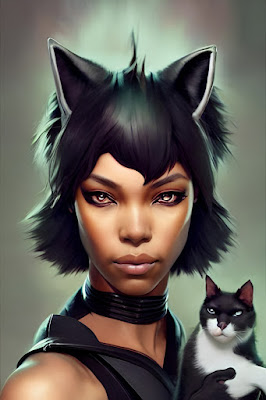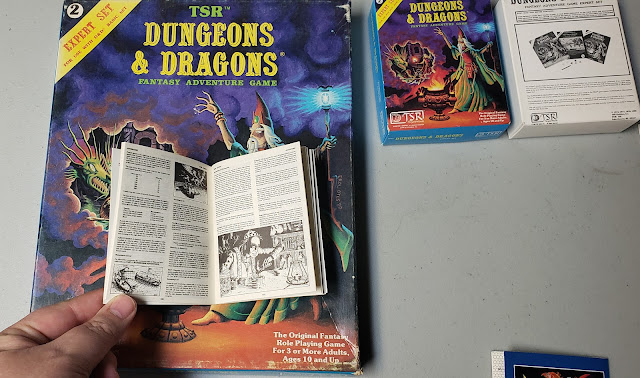I have not done one of these in a while, and this one seems like a no-brainer.
The Basic/BX/BECMI Witches
Maybe more so than AD&D, the witch, in one form or the other, has been a part of the Basic D&D game from the early days.
Holmes Basic
The "Holmes Witch" has been talked about in old-school blogs for years,
mine included. The so-called Holmes witch never materialized, but it kept us waiting for years and kept bloggers entertained for even longer.
GAZ3: Principalities of Glantri
This is, without a doubt, my favorite of all the Gazetteers and one of my all-time favorite Basic-era books.
I reviewed this book in depth a while back and one of the most overt witches in my Basic book collection.
The Witches of Glantri are some of the most detailed of the Basic-era witches. It's no lie, that red-head on the cover of the Glantri book was one of the inspirations for where I took my own witch character, even if the book came out a year after I rolled up the character (July 1986 for the character and June of 87 for the Glantri book if I remember right. OR at least that was when I got it).
One thing I don't care for so much with this class is the charisma reduction, but it seems to come up a lot.
I detailed at least one witch,
Skylla, using this witch class and it worked out well. Also, years and years ago,
I redid the Glantri witch to make it something closer to my Complete Netbook of Witches for AD&D 2nd ed.
In the AD&D 2nd Ed version of this book,
Glantri: Kingdom of Magic, the witch is completely replaced by the Wokani.
GAZ7: Northern Reaches
This Gazetteer covers the lands Ostland, Vestland, and the Soderfjord Jarldoms. I REALLY wanted to use this back in the 80s with the G-Series.
This book features the
Wise Woman (Witches). This class is considered an NPC Class, but we all know what that means right? They get a nice balance of both Magic-user and Cleric spells (up to the 6th level), along with the ability to use magical runes. I kinda wish I had done more with runes in my own Winter Witch book.
The treat I found here was Carrah the Witch Queen of Hel. Given the focus on Basic/Expert rules, I would likely have made her 14th level. Or more likely 13th. But there is some good backstory on her here. While the temptation would be to make her a
Winter Witch, I think given her unliving status and her ties to Hel she might be more of a
Mara Witch. Maybe a Winter Witch who had been in a Mara coven.
D&D Master Rules Boxed Set
The D&D Master Rules, also the one I know the least about, has rules for non-human spell casters. Shamans, who can use cleric and druid spells, and the Wicca who can use Magic-user spells. The list of spells given to Wicca certainly has a witch feel to them. They are really only missing a cure spell or two.
Spells Usable by Wiccas
First Level Magic-User Spells
Detect Magic (B39)
Light (B40)
Protection from Evil (B40)
Read Languages (B40)
Read Magic (B40)
Sleep (B40)
Second Level Magic-User Spells
Continual Light* (B41, XI1)
Detect Evil (B41)
Detect Invisible (B41)
Invisibility (B41)
Levitate (B42)
Web (B42)
Third Level Magic-User Spells
Clairvoyance (XI1)
Dispel Magic (XI1)
Fire Ball (XI1)
Fly (XI2)
Lightning Bolt (Xl2)
Water Breathing (XI2)
Fourth Level Magic-User Spells
Charm Monster (X13)
Growth of Plants* (XI3)
Ice Storm/Wall (X13)
Massmorph(X13)
Remove Curse* (X14)
Wall of Fire (XI4)
Fifth Level Magic-User Spells
Animate Dead (XI4)
Cloudkill(X14)
Dissolve* (C20)
Hold Monster* (XI5)
Pass-Wall (XI5)
Wall of Stone (X15)
Sixth Level Magic-User Spells
Death Spell (XI6)
Move Earth (C21)
Projected Image (X16)
Reincarnation (C21)
Stone to Flesh* (XI6)
Wall of Iron (C21)
* reversible spell
The shaman and wicca are used throughout the Basic line in future books, though the name would later be changed to Wokan or Wokani.
GAZ10: Orcs of Thar
This Gazetteer covers playing orcs, goblinoids, gnolls and other humanoid creatures. It also has a guide for using the book with AD&D. Goblinoid wicca are featured here but they use the rules already outlined in the Master's book.
PC1 Tall Tales of the Wee Folk
Several non-human creatures are given options for Wicca levels. There are also plenty of new spells for Fairy spell-casters. Many have since gone on in other products to have even stronger witch associations. I
reviewed this one in-depth yesterday.
PC2 Top Ballista
This also covers several spellcaster non-humans and new races. In particular, we get gnomes and harpy wicca. Gnomes advance to level 12 as wicca which is not too bad really.
PC3 The Sea People
Sea Wicca are also presented in this book but by this time we know what to expect.
D&D Rules Cyclopedia
By this point, the Wicca has been renamed to the Wokan, or the plural Wokani. The spells usable are largely the same. That is to say, no obvious differences jumped out at me. It also includes a fairly comprehensive list of monsters and what level they can advance to. Interestingly enough Hags do not cast as Wokani, but rather they cast as clerics.
So. Wicca, Wise Women, and Wokani. All three share a certain level of similarity and have, over the editions, been used in place of the other. A good example takes all the way back to the dawn of D&D, Dave Arneson's Blackmoor. Not the original Blackmoor, but the versions we got from 3rd and 4th edition. For the
4th edition rules I talked a bit about the Wokani and their relationship to both witches and druids. That version is no longer available, but the
3rd Edition version is.
Dave Arneson's Blackmoor Core Campaign Book
This is not a Basic-era book. This is a 3rd Edition book, or more to the point, a d20 book. I bring it up only because we get the Wokani here again. They read more like primitive arcane spellcasters with a closer tie to the natural world. That would work fine with most of the products above, to be honest. These casters use wisdom as their prime and spellcasting ability. The Blackmoor connection intensifies with it sharing a few gods with the Basic Gazetteers. In particular Hel (Gaz7) and Hella (Blackmoor). There are more, but that is the one that interests me the most.
The Wokani here seems to move further away from the Glantri Witch, but there are still plenty of commonalities.
Honorable Mentions
I could let things go without a mention of the witches
Karelena, Solorena & Trilena from
Rahasia. Though these seem to be more of the "witches as weird female magic-users" rather than as witches as I usually mean.
Also, the
witch class from Dragon Magazine #20 should get a mention as well.
There is a lot of material here, but not say as much as you could find for the wizard or cleric. The witch remains one of the great almost-classes of D&D. Given the dates of all of these works including
Dragon Magazine #114, it seems I was tapping into something needed back in 86. Or, more to the point, we were all exposed to the same influences in culture and this is another fine example of parallel development.




















































